› Forums › Variable Stars › V404 Cyg
- This topic has 15 replies, 7 voices, and was last updated 10 years, 6 months ago by
 Bill Ward.
Bill Ward.
-
AuthorPosts
-
19 June 2015 at 12:41 am #573444
 Nick JamesParticipant
Nick JamesParticipantThis unusual variable is in outburst for the first time since 1989 (see the Variable Star Section page). It is thought to be a binary system with a black hole at the centre. It’s currently clear here in Chelmsford and I am doing multi-colour photometry on the system. It is around mag 12 in Ic, mag 13 in Rc and mag 14 in V but it is varying rapidly with a large amplitude as shown in the attached lightcurve. This star is definitely worth observing if you have the chance.
Nick.
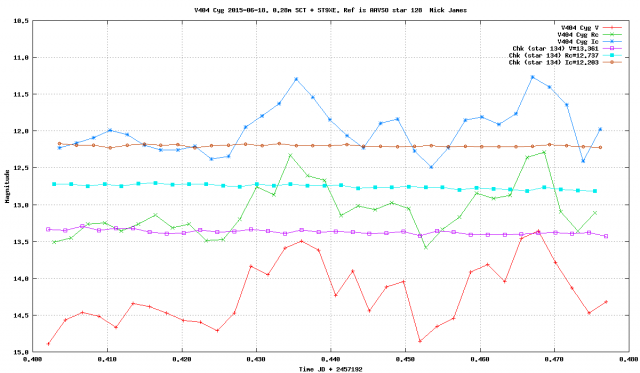
Attachments:
19 June 2015 at 6:27 am #576887 Nick JamesParticipant
Nick JamesParticipantHere’s the updated lightcurve covering the whole of last night.
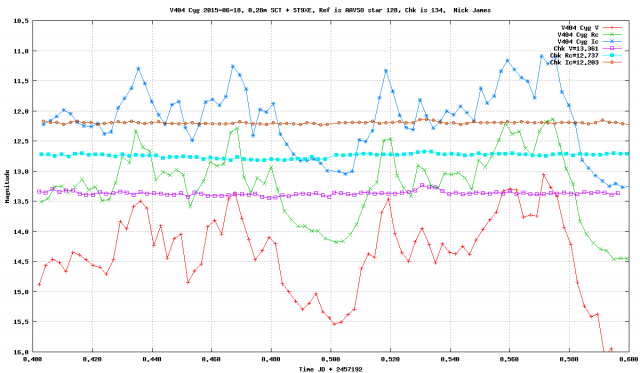 20 June 2015 at 11:58 am #576888
20 June 2015 at 11:58 am #576888 Paul G. AbelParticipant
Paul G. AbelParticipantA nice set of observations Nick!
The changes in magnitude are really quite spectacular. I have to confess I can’t immediately explain these large changes in luminosity. Of course, accretion disks are very dynamical and complex processes occur within them. Now in the case of variable quasars, it has been recently suggested that if the accretion disk is not homogeneous and there are large local temperature changes, then this can result in the light being somewhat bluer when the qusar brightens and one would expect spectral variablility. I am not certain whether this mechanism could explain the osbervations in a binary system, but it would certainly be my first course of investigation!
The paper on large temperature fluctations in Quasar disks can be found here arXiv:1401.1211
Best wishes,
-Paul
20 June 2015 at 2:04 pm #576890 Jeremy ShearsParticipant
Jeremy ShearsParticipantIndeed some pretty esciting data from Nick. Incredible to think we are looking at the secondary effects of a black hole.
Paul, I am not sure I know what is causing these variations. Much of the work on V404 Cyg has been whilst it was in quiescence, where large variations, or flares, are also seen. One idea is that the flares are caused by local magnetic reconnection events in or above the accretion disc. The theory goes that a dynamo mechanism, driven by the strong shear produced by differential rotation, operates in accretion discs, and regions of oppositely directed magnetic fields develop within the disc or between the disc and corona and reconnect explosively. There’s more discussion in the MNRAS paper: http://cdsbib.u-strasbg.fr/cgi-bin/cdsbib?2003MNRAS.346.1116S
However, maybe in outburst it’s something else? I am sure that the current outburst will reveal more – and much of the new data will be contributed by amateur astronomers!
I hope others will get a chance to see such a rare outburst of this peculiar system before it fades.
Go well!
Jeremy
21 June 2015 at 8:12 am #576891 Nick JamesParticipant
Nick JamesParticipantI managed a very short run of less than an hour last night in a short clear patch. There was a lot of variation (> 1 mag). Peak mags were 9.8 in Ic, 11.8 in V.
21 June 2015 at 10:44 am #576892 Richard MilesParticipant
Richard MilesParticipantThese r-band data were recorded from McDonald. Not quite overlapping with your data, Nick.
21 June 2015 at 11:45 am #576893 Gary PoynerParticipant
Gary PoynerParticipantHad 90 mins of sky last night, and was able to see short term variations (minutes) of 0.5 mag. I don’t recall V404 Cyg doing this in 1989. I certainly didn’t make any notes of short term variations. Pretty sure I would have recorded them. Still can’t believe it’s been 26 years since I last ‘saw’ this beast (except on BRT images of course) 😉
It’s possible that these variations are caused by the jet as well as the disc and other phenomenon in the active area. I’m pretty sure we’ll know a lot more once this outburst is over!
Gary
21 June 2015 at 6:25 pm #576895 Nick JamesParticipant
Nick JamesParticipantRichard,
The McDonald data is very nice. It shows what can be done with a 2.1m telescope and a specially designed photometer running with a 2s cadence. The Argos photometer is described here.
24 June 2015 at 12:15 am #576899 Nick JamesParticipant
Nick JamesParticipantI’m observing V404 Cyg again tonight this time using 30s exposures in Ic. The lightcurve so far tonight is attached. The mean Ic mag is around 10.4 and there are variations of a few tenths of a mag. Nothing like as spectacular as a few nights ago.
24 June 2015 at 3:55 am #576900 Nick JamesParticipant
Nick JamesParticipantIt got a bit more interesting later in the night.
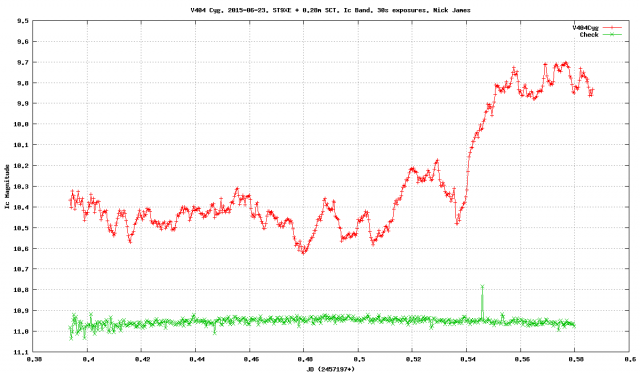 25 June 2015 at 6:30 am #576901
25 June 2015 at 6:30 am #576901 Paul Anthony BrierleyParticipant
Paul Anthony BrierleyParticipantGood morning,
This is very interesting. I will try and grab an image of V404 if the skies remain clear after sunset.
25 June 2015 at 7:50 am #576902 Nick JamesParticipant
Nick JamesParticipantI did another run of 4 hrs last night and V404 Cyg was at around Ic=10.2 with variation of around 0.3 mags. We seem to be getting the boring bit of the lightcurve at our longitudes as you can see from the attached AAVSO Ic lightcurve. My observations are the ones in blue.
It’s definitely worth keeping this object under close observation.
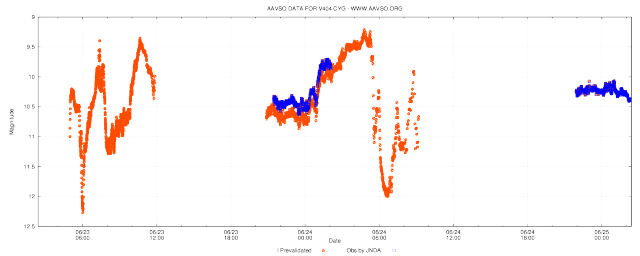 25 June 2015 at 11:46 pm #576905
25 June 2015 at 11:46 pm #576905 Nick JamesParticipant
Nick JamesParticipantI’ve been doing an Ic Band run on V404 Cyg tonight with 30s exposures. The conditions are dreadful with drifting cloud and haze but the star is currently varying rapidly. It has just dropped from Ic=9.7 to Ic=11.6 in 12 minutes!
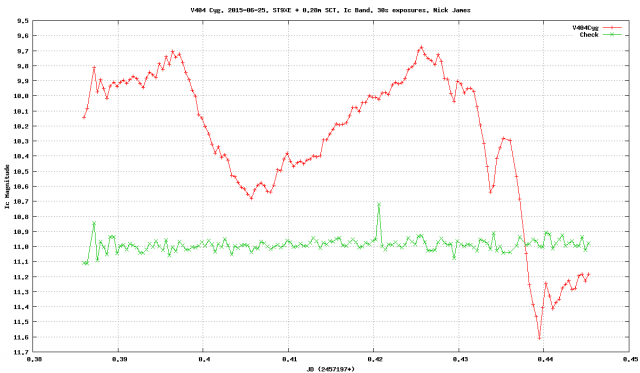 26 June 2015 at 4:16 pm #576906
26 June 2015 at 4:16 pm #576906 Gary PoynerParticipant
Gary PoynerParticipantNick,
You commented that you might have a go visually. Did you? I hope you did 🙂
Gary
26 June 2015 at 8:25 pm #576907 Nick JamesParticipant
Nick JamesParticipantI did, but visual observing is so hard compared to imaging!
I only have a C6 for visual use mounted on a Vixen Sphinx mount. It found the field without problems and I used around x150 but the conditions were so grotty that I could only see down to mag 12.5 or so (I could clearly see AAVSO star 111 but star 125 was right on the limit). I started to observe around 2240 UT and initially I couldn’t see V404 Cyg. It then gradually became visible until around 2320 when it disappeared over a period of a few minutes even though stars of similar brightness were still there. Ten minutes later it was back and brightening but I had to go to bed…
I must admit it was very nice to see photons from a black hole jet with my own eyes but it made me realise how good CCDs are for imaging things in light-polluted places!
Nick
29 June 2015 at 12:42 pm #576908 Bill WardParticipant
Bill WardParticipantHi,
Whilst I was a diligent physics student many moons ago I’m afraid my magneto-hydrodynamics at an event horizon is a bit ropy….
However, it is always interesting to see an analogue that demonstrates the physics more clearly than any equation!
Take a look at this story on the BBC News website: http://www.bbc.co.uk/news/world-us-canada-33282343
A great big vortex in a lake being drained to control flooding. What is REALLY interesting is the spontaneous generation of instabilities that propogate UPWARDS out of the vortex throat and against the flow. #4 right at the end is the best! Stretch the plughole analogy to curved space (that is imaging the ring of foamy water being a sphere) and what we might have at V404 is a smilar event. The “flooding” is accrection of new material and the flaring is instabilities of material flashing around the event horizon. I wonder how long before this will appear in a paper somewhere. What do you know!, it happens right here on Earth, just not so violently…… 😉
cheers,
Bill.
-
AuthorPosts
- You must be logged in to reply to this topic.
